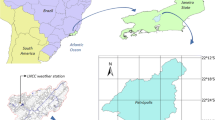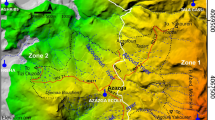Abstract
Bhutan is highly prone to landslides, particularly during the monsoon season. Several landslides often occur along the Phuentsholing–Thimphu highway, a very important infrastructure for the country. Worldwide, empirical rainfall thresholds represent a widely used tool to predict the occurrence of rainfall-induced landslides. Nevertheless, no thresholds are currently designed and proposed for any region in Bhutan. In this work, we define empirical cumulated event rainfall–rainfall duration thresholds for the possible initiation of landslides using information on 269 landslides that occurred between 1998 and 2015 along the 90-km highway stretch between the towns of Phuentsholing and Chukha, in southwestern Bhutan, and daily rainfall measurements obtained from three rain gauges. For this purpose, we apply a consolidated frequentist method and use an automatic tool that identifies the rainfall conditions responsible for the failures and calculates thresholds at different exceedance probabilities and the uncertainties associated with them. Analyzing rainfall and landslide data, we exclude from the analysis all the landslides for which the rainfall trigger is not certain, so we reduce the number of landslides from 269 to 43. The calculated thresholds are useful to identify the triggering conditions of rainfall-induced landslides and to predict the occurrence of the failures in the study area, which is, to date, poorly studied. These rainfall thresholds might be implemented in an early warning system, in order to reduce the risk posed by these phenomena to the population living and traveling along the investigated road stretch.





Similar content being viewed by others
References
Brunetti MT, Peruccacci S, Rossi M, Luciani S, Valigi D, Guzzetti F (2010) Rainfall thresholds for the possible occurrence of landslides in Italy. Nat Hazards Earth Syst Sci 10:447–458. https://doi.org/10.5194/nhess-10-447-2010
Cepeda J, Höeg K, Nadim F (2010) Landslide-triggering rainfall thresholds: a conceptual framework. Q J Eng Geol Hydrogeol 43:69–84. https://doi.org/10.1144/1470-9236/08-066
Chen HX, Wang JD (2014) Regression analyses for the minimum intensity-duration conditions of continuous rainfall for mudflows triggering in Yan’an, northern Shaanxi (China). Bull Eng Geol Environ 73:917–928. https://doi.org/10.1007/s10064-013-0567-3
Cruden DM, Varnes DJ (1996) Landslide types and processes. In: Turner AK, Schuster RL (eds) Landslides: investigation and mitigation. Transportation Research Board special report 247. National Academy Press, Washington DC, pp 36–75
Dawson AR, Neves LAC, Sarkar R, Dijkstra T (2018) Bhutanese road and bridge resilience to floods and landslides—first suggestions for assessment and response. Proc. of 37th Annual Southern African Transport Conference, 9-12 July 2018, Pretoria, South Africa, pp 48–57
Dikshit A, Satyam DN (2018) Estimation of rainfall thresholds for landslide occurrences in Kalimpong, India. Innov Infrastruct Solut 3:24. https://doi.org/10.1007/s41062-018-0132-9
Dunning SA, Massey CI, Rosser NJ (2009) Structural and geomorphological features of landslides in the Bhutan Himalaya derived from terrestrial laser scanning. Geomorphol 103:17–29. https://doi.org/10.1016/j.geomorph.2008.04.013
Froude MJ, Petley DN (2018) Global fatal landslide occurrence from 2004 to 2016. Nat Hazards Earth Syst Sci 18:2161–2181. https://doi.org/10.5194/nhess-18-2161-2018
Gansser A (1983) Geology of the Bhutan Himalaya. Birkhaüser Verlag, Basel, Switzerland, 181 pp
Gariano SL, Guzzetti F (2016) Landslides in a changing climate. Earth Sci Rev 162:227–252. https://doi.org/10.1016/j.earscirev.2016.08.011
Greenwood LV, Argles TW, Parrish RR, Harris NBW, Warren C (2016) The geology and tectonics of central Bhutan. J Geol Soc 173(2):352–369. https://doi.org/10.1144/jgs2015-031
Guzzetti F, Peruccacci S, Rossi M, Stark CP (2008) The rainfall intensity–duration control of shallow landslides and debris flows: an update. Landslides 5(1):3–17. https://doi.org/10.1007/s10346-007-0112-1
Gyeltshen P, Norbu C (2013) Strategies and options to address land degradation due to landslides: Bhutanese scenarios. In: Margottini P, Canuti P, Sassa K (eds) Landslide science and practice. Volume 4: global environmental change. Springer-Verlag, Berlin Heidelberg, pp 177–182. https://doi.org/10.1007/978-3-642-31337-0_23
Haque U, Blum P, da Silva PF, Andersen P, Pilz J, Chalov SR, Malet J-P, Jemec Auflič M, Andres N, Poyiadji E, Lamas PC, Zhang W, Peshevski I, Pétursson HG, Kurt T, Dobrev N, García-Davalillo JC, Halkia M, Ferri S, Gaprindashvili G, Engström J, Keelling D (2016) Fatal landslides in Europe. Landslides 13(6):1545–1554. https://doi.org/10.1007/s10346-016-0689-3
Kuenza K, Dorji Y, Wangda D (2010) Landslides in Bhutan. In: Proceedings of the SAARC Workshop on Landslide Risk Management in South Asia, Thimphu, Bhutan, 11–12 May 2010, pp 73–80
Lainas S, Sabatakakis N, Koukis G (2016) Rainfall thresholds for possible landslide initiation in wildfire-affected areas of western Greece. Bull Eng Geol Environ 75(3):883–896. https://doi.org/10.1007/s10064-015-0762-5
Li Y, Ma C, Wang Y (2017) Landslides and debris flows caused by an extreme rainstorm on 21 July 2012 in mountains near Beijing, China. Bull Eng Geol Environ 1–16. https://doi.org/10.1007/s10064-017-1187-0
Marjanović M, Krautblatter M, Abolmasov B, Đurić U, Sandić C, Nikolić V (2018) The rainfall-induced landsliding in Western Serbia: a temporal prediction approach using decision tree technique. Eng Geol 232:147–159. https://doi.org/10.1016/j.enggeo.2017.11.021
Martinović K, Gavin K, Reale C, Mangan C (2018) Rainfall thresholds as a landslide indicator for engineered slopes on the Irish Rail network. Geomorphol 306:40–50. https://doi.org/10.1016/j.geomorph.2018.01.006
Meenawat H, Sovacool BK (2011) Improving adaptive capacity and resilience in Bhutan. Mitig Adapt Strat Glob Change 16(5):515–533. https://doi.org/10.1007/s11027-010-9277-3
Melillo M, Brunetti MT, Peruccacci S, Gariano SL, Guzzetti F (2015) An algorithm for the objective reconstruction of rainfall events responsible for landslides. Landslides 12(2):311–320. https://doi.org/10.1007/s10346-014-0471-3
Melillo M, Brunetti MT, Peruccacci S, Gariano SL, Guzzetti F (2016) Rainfall thresholds for the possible landslide occurrence in Sicily (southern Italy) based on the automatic reconstruction of rainfall events. Landslides 13(1):165–172. https://doi.org/10.1007/s10346-015-0630-1
Melillo M, Brunetti MT, Peruccacci S, Gariano SL, Roccati A, Guzzetti F (2018) A tool for the automatic calculation of rainfall thresholds for landslide occurrence. Environ Model Softw 105:230–243. https://doi.org/10.1016/j.envsoft.2018.03.024
Norbu C, Baillie I, Dema K, Tamang HB, Turkelboom F (2003) Types of land degradation in Bhutan. J Bhutan Stud 8:88–114
Peruccacci S, Brunetti MT, Luciani S, Vennari C, Guzzetti F (2012) Lithological and seasonal control on rainfall thresholds for the possible initiation of landslides in central Italy. Geomorphol 139–140:79–90. https://doi.org/10.1016/j.geomorph.2011.10.005
Peruccacci S, Brunetti MT, Gariano SL, Melillo M, Rossi M, Guzzetti F (2017) Rainfall thresholds for possible landslide occurrence in Italy. Geomorphol 290:39–57. https://doi.org/10.1016/j.geomorph.2017.03.031
Petley D (2012) Global patterns of loss of life from landslides. Geology 40(10):927–930. https://doi.org/10.1130/G33217.1
Piciullo L, Gariano SL, Melillo M, Brunetti MT, Peruccacci S, Guzzetti F, Calvello M (2017) Definition and performance of a threshold-based regional early warning model for rainfall-induced landslides. Landslides 14:995–1008. https://doi.org/10.1007/s10346-016-0750-2
Piciullo L, Calvello M, Cepeda JM (2018) Territorial early warning systems for rainfall-induced landslides. Earth Sci Rev 179:228–247. https://doi.org/10.1016/j.earscirev.2018.02.013
Prokop P, Walanus A (2017) Impact of the Darjeeling–Bhutan Himalayan front on rainfall hazard pattern. Nat Hazards 89:387–404. https://doi.org/10.1007/s11069-017-2970-8
Rosi A, Peternel T, Jemec-Auflič M, Komac M, Segoni S, Casagli N (2016) Rainfall thresholds for rainfall-induced landslides in Slovenia. Landslides 13:1571–1577. https://doi.org/10.1007/s10346-016-0733-3
Saito H, Nakayama D, Matsuyama H (2010) Relationship between the initiation of a shallow landslide and rainfall intensity–duration thresholds in Japan. Geomorphol 118:167–175. https://doi.org/10.1016/j.geomorph.2009.12.016
Segoni S, Piciullo L, Gariano SL (2018) A review of the recent literature on rainfall thresholds for landslide occurrence. Landslides 15(8):1483–1501. https://doi.org/10.1007/s10346-018-0966-4
Sengupta A, Gupta S, Anbarasu K (2010) Rainfall thresholds for the initiation of landslide at Lanta Khola in North Sikkim, India. Nat Hazards 52:31–42. https://doi.org/10.1007/s11069-009-9352-9
Soto J, Palenzuela JA, Galve JP, Luque JA, Azañón JM, Tamay J, Irigaray C (2017) Estimation of empirical rainfall thresholds for landslide triggering using partial duration series and their relation with climatic cycles. An application in southern Ecuador. Bull Eng Geol Environ 1–17. https://doi.org/10.1007/s10064-017-1216-z
Staley DM, Kean JW, Cannon SH, Schmidt KM, Laber JL (2013) Objective definition of rainfall intensity–duration thresholds for the initiation of post-fire debris flows in southern California. Landslides 10:547–562. https://doi.org/10.1007/s10346-012-0341-9
Tiranti D, Rabuffetti D (2010) Estimation of rainfall thresholds triggering shallow landslides for an operational warning system implementation. Landslides 7:471–481. https://doi.org/10.1007/s10346-010-0198-8
Valenzuela P, Domínguez-Cuesta MJ, Mora García MA, Jiménez-Sánchez M (2018) Rainfall thresholds for the triggering of landslides considering previous soil moisture conditions (Asturias, NW Spain). Landslides 15(2):273–282. https://doi.org/10.1007/s10346-017-0878-8
Vessia G, Pisano L, Vennari C, Rossi M, Parise M (2016) Mimic expert judgement through automated procedure for selecting rainfall events responsible for shallow landslide: a statistical approach to validation. Comput Geosci 86:146–153. https://doi.org/10.1016/j.cageo.2015.10.015
Zêzere JL, Vaz T, Pereira S, Oliveira SC, Marques R, Garcia RAC (2015) Rainfall thresholds for landslide activity in Portugal: a state of the art. Environ Earth Sci 73(6):2917–2936. https://doi.org/10.1007/s12665-014-3672-0
Acknowledgements
The authors thank the various agencies of the Royal Government of Bhutan for providing rainfall data and the Border Roads Organisation, Government of India (DANTAK project) for providing landslide data. The authors also thank the staff and students of the College of Science and Technology, Royal University of Bhutan, Rinchending. Stefano Luigi Gariano was supported by a grant from NERC in the framework of the LANDSLIP project (grant number NERC/DFID NE/P000681/1). Raju Sarkar was supported by a grant from the BRACE project (grant number NERC/GCRF NE/P016219/1). The authors acknowledge the two anonymous reviewers for their useful comments and suggestions.
Author information
Authors and Affiliations
Corresponding author
Rights and permissions
About this article
Cite this article
Gariano, S.L., Sarkar, R., Dikshit, A. et al. Automatic calculation of rainfall thresholds for landslide occurrence in Chukha Dzongkhag, Bhutan. Bull Eng Geol Environ 78, 4325–4332 (2019). https://doi.org/10.1007/s10064-018-1415-2
Received:
Accepted:
Published:
Issue Date:
DOI: https://doi.org/10.1007/s10064-018-1415-2




